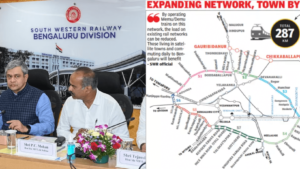
bengaluru
Introduction:
With the unveiling of a circular train that would span 287 kilometers, Bengaluru, which is the bustling information technology hub of India, is on the verge of experiencing a first-of-its-kind development in its transportation infrastructure.
This ambitious initiative was revealed by Railway Minister Ashwini Vaishnaw during a press conference that took place after a thorough examination of the various railway projects in Bengaluru.
Comprehensive connectivity over seven different pathways is the vision for the future.
It is the goal of the circular railway to connect important towns in the Bengaluru area, thereby creating the most extensive network in India. This idea goes beyond the requirements of the present and envisions a transportation solution for the next forty to fifty years.
When considered in conjunction with the Bengaluru Suburban Railway Project (BSRP), it materializes as the ultimate solution to the ever-changing transportation requirements of the metropolis.
Research on Feasibility and Alignment Receives Unprecedented Financial Support
A feasibility and alignment study amounting to seven crore rupees has been granted by Minister Ashwini Vaishnaw in recognition of the considerable discussions that have taken place over Bengaluru’s circular railway.
The success of the project and the fulfillment of the ever-evolving requirements of the city are both dependent on this crucial undertaking.
The circular railway, which would be longer than Chennai’s network of 235.5 kilometers, has the potential to become India’s greatest suburban railway if it were to be implemented.
A Possible Timeline: Something That Could Happen Within the Next Five Years?
Despite the fact that the minister did not provide a specific timetable, reputable sources within the South Western Railway (SWR) have indicated that the circular railway might become a reality within the next five years, provided that all goes according to plan.
The proposed circular train is intended to be constructed in accordance with a hub-and-spoke plan, which will allow for the seamless integration of the city’s core with seven spokes that are situated roughly 20-25 kilometers distant.
What is the Difference Between the Peripheral Ring Road (PRR) and the Railways’ Version of the Concept?
In its most basic form, the circular railway can be understood as the similarity between the rails and the Peripheral Ring Road (PRR).
Minister Vaishnaw offered some insight into the proposed route, noting a Nidavanda-Nidavanda line that would pass through Doddaballapur, Devanahalli, Malur, Heelalige, Hejjala, and Solur.
It is considered that the rail-based system will improve public transportation in a manner that is comparable to the successful models that have been implemented in other global cities such as Tokyo, London, Delhi, or Bengaluru.
Investigation of the Possibilities and Next Steps
The feasibility and alignment study, which is going to be carried out by the SWR’s Construction Organisation, is an essential first step.
In the near future, it is predicted that the research will be soliciting bids, and the report is projected to be completed by September 2024.
Following that, it is anticipated that a Detailed Project Report (DPR) will be launched in the year 2025, with the completion of the DPR possibly taking up to one year.
It is possible that the construction of 80–90 kilometers of the circular railway might be completed per year if all goes according to plan. A minimum of two tracks will be included in the railway network, and the entire network will be fully electrified.






